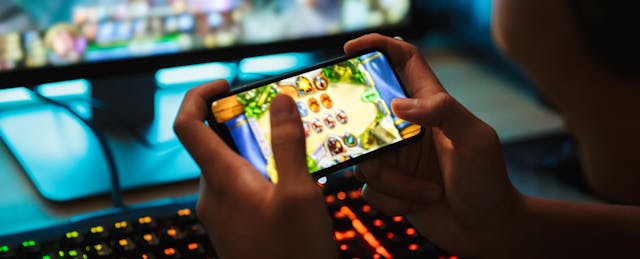If you had to guess how much time teenagers spend using screens outside of work each day, how many hours would you guess? Two? Four? How about nine? According to Common Sense Media, teens today are spending an average of nine hours a day online, while kids from ages eight to 12 are spending an average of six.
That’s a lot of time on screens. Even teens themselves are beginning to think they’re overdoing it: Recent Pew research shows that 54 percent of U.S. teens say they spend too much time on their cellphones, and two-thirds of parents express concern over their teen's screen time. Due to an array of negative effects on health and sleep, The American Academy of Pediatrics (AAP) released a report recommending that children have two hours or less of sedentary screen time daily.
This excessive passive screen use may also be negatively affecting our children’s imaginations. One out of every three American teenagers has not read a book for pleasure in a year, and in the U.K., a new study reported that young children are spending twice as long looking at screens as they do playing outside.
This isn’t to say that all screen time is bad for our kids. However, there is a very fine line between passive screen time, defined as when a child passively consumes digital content with no thought, creativity or interaction required to progress, and active screen time, which involves cognitive thought and/or physical engagement. Many parents and teachers may be surprised to learn how many consequences there are when we let our kids spend too much time using screens passively—and why it’s so vital for us to change how kids are using their computers and phones.
The Surprising Consequences of Passive Screen Use
As our children find themselves increasingly surrounded by digital devices, it’s easier than ever for them to experience the negative side effects of passive screen use. Several studies in recent years have shown that too much passive screen time is making kids moody, stressed and lazy.
Although modern devices have increased overall screen time, these effects are nothing new: A Yale University review of 173 medical studies of screen time use conducted since 1980 found that in 75 percent of these studies, the research indicated that the more time a child spends with screens and media, the more likely he or she is to be impacted with negative health outcomes.
Besides affecting our children’s physical health, it looks like passive screen use may also be affecting kids’ learning and creativity as well. At home, many children and teenagers use entertainment media at the same time that they are engaged in other tasks, such as homework—and evidence increasingly suggests that the use of media while engaged in academic tasks has negative consequences on learning. If we want to help our children properly develop essential life skills like self-regulation, creativity and learning, we must encourage them to turn passive screen time into both physical play and active screen time.
Why Research Backs Active Screen Time
Passive screen time has its problems, but this doesn’t mean that kids and teens can’t use screens in a healthy, beneficial way. After studying children ages 4 to 11 on their use of screen time, a University of Michigan study found that “how children use the devices, not how much time they spend on them, is the strongest predictor of emotional or social problems connected with screen addiction.” As long as we ensure that our kids are actively using their screens, we can most likely avoid the problems that come with passive screen use.
The key to changing how our kids use their screens starts with knowing which activities are passive and which are not. Whereas passive screen time includes common activities like scrolling through social media, watching TV or videos on YouTube, or even playing games that don’t require thinking, we can make smart use of our children’s screen time by ensuring we limit those passive activities and instead encourage active ones.
According to an Australian study on active and passive screen uses, there are actually two types of active screen use: physical and cognitive. Kids can actually get similar benefits to physical exercise when they play with active video game systems like the Nintendo Switch, XBox Kinect or Pokemon Go.
Playing active games has been proven to have similar effects to moderate walking, skipping and jogging. There are also plenty of active screen uses that spark the cognitive side of the brain.
Studies show that children respond to activity-based programming when it is fun, designed for them and encourages imitation or participation. These can include learning a new skill like coding games or websites, creating music, writing and publishing stories or poetry, or simply anything else that requires them to use the creative side of their brains. Given that screen time will continue to play a big part in kids’ lives, let’s help guide them to smarter choices.


